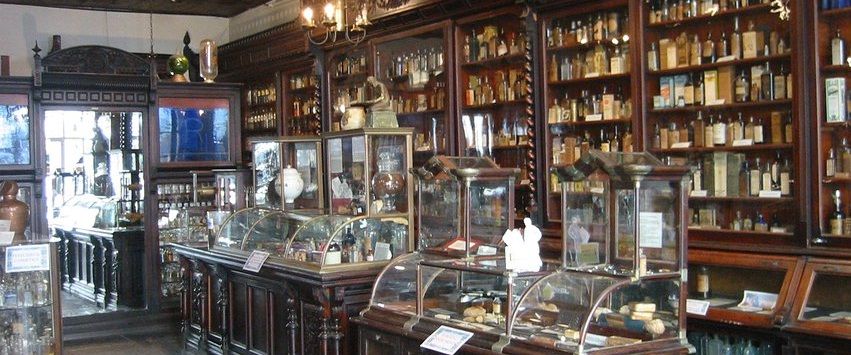New Orleans: Home to America's First Licensed Pharmacy
Just a few blocks away from the Mississippi River, in New Orleans' French Quarter, sits a piece of medical history - the apothecary shop of America's first licensed pharmacist.

Just a few blocks away from the Mississippi River, in New Orleans’ French Quarter, sits a piece of medical history — the apothecary shop of America’s first licensed pharmacist.
Louis Joseph Dufilho, Jr. of New Orleans became America’s first licensed pharmacist in the early 1800s and he opened the shop that is now home to the New Orleans Pharmacy Museum in 1823. The museum didn’t open until 1950 after the building had been damaged in a hurricane and abandoned.

A first glance at the museum reveals that it is packed with history. The walls are lined with shelves brimming with glass jars and bottles and an old soda fountain graces the floor. The museum doesn’t shy away from medicine’s more questionable and horrific past, either. Cases also house sharp and terrifying medical instruments (like bone saws) and even wriggling, live leeches.
Based in New Orleans, it is unsurprising that the museum would have a special exhibit dedicated to voodoo. According to Executive Director Elizabeth Sherman, there were African American-run pharmacies, or hoodoo shops, in the area but Dufilho also sold voodoo potions, which were numbered so they could be ordered discretely.
“[Dulfilho] learned how to make some of the voodoo potions from the local priestess and then he would sell them under the counter at his French pharmacy just because there was a draw for it,” Sherman explains. “In some cases it might have been socially unacceptable or against your religion to see a voodoo priestess but people were curious, wanted to experiment, so you could come to your regular pharmacist and order voodoo potions.”
Guests also can visit a re-created 19th century physician’s study. The building’s second owner, after Dufilho, was a physician who had a practice on the second floor. The study features instruments, early anesthetics and other artifacts discovered right in the museum’s backyard. The building’s old privy, which also was used to dump trash, broken bottles and other refuse, yielded a cache of both residential and apothecary artifacts, according to Sherman
An earlier seasonal exhibit, called Acqua Vitale, told the history of alcohol in medicine. Even during Prohibition pharmacists were administering alcohol as medicine, so people could get whiskey from the pharmacy, according to Sherman. The exhibit also highlights how absinthe started out as medicinal and the alcohol found in the original versions of Coke and 7-Up.
Sherman says that visitors to the museum are probably most shocked by the prevalent the use of narcotics in medical care. Even in the 19th century tampons were dipped in opium and belladonna to deal with menstrual cramps, she explains.

“You see the patent medicines are 25 percent or more alcohol, a lot of them have some kind of narcotic,” Sherman says. “Obviously they didn’t have any concept of drug addiction at the time.”
The New Orleans Pharmacy Museum is largely self guided, although there is a tour at noon on Thursday and Friday. The guided tour is mainly on the first floor and lasts a total of 45 minutes.
“You learn really a more in depth look at the history of 19th century New Orleans culture and how pharmacy, medical, surgical health care intertwined with that,” says Elizabeth Sherman, executive direction of the museum.
Outside, the museum bridges the past with the present day. The courtyard contains a garden of herbs used for medicinal purposes in earlier years and today. Visitors will see aloe, rue, wormwood, sage and more herbs that naturopathic doctors still use.
The French Quarter
Since most of the present-day buildings were built under Spanish rule, the French Quarter isn’t quite as French as one might think. The entire district, which was the center of the city when New Orleans was founded in 1718, is a National Historic Landmark. Since the 1920s the historic buildings have been protected by law and cannot be demolished.

Jackson Square and the French Quarter Visitor Center are less than a five-minute walk from the Pharmacy Museum. On weekends the local artists display and sell their wares in the square, where visitors will also find street bands and even tarot readings.
Across the street from the square is St. Louis Cathedral, one of the oldest cathedrals in the United States. The site has been home to three different Roman Catholic churches: the first a wooden structure in 1718; then a brick and timber church completed in 1727 that was destroyed in the Great New Orleans Fire of 1788; and finally, the current cathedral.
No visit to the French Quarter would be complete without a walk down nearby Bourbon Street (Rue Bourbon), if only just to see the many bars. Since this area is packed with bars and taverns, expect to see people drinking on the street — New Orleans is one of just eight places in the United States where open containers are always permitted on the street.
